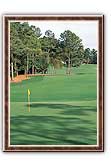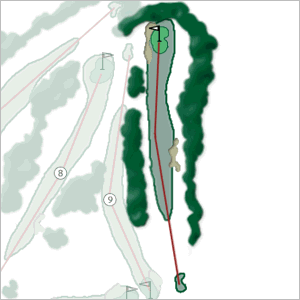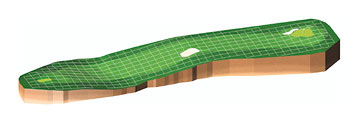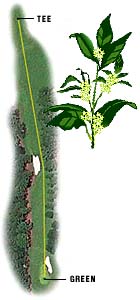| Hole Names | |
|
|
|

Hole #1Tea OliveOsmanthus fragrans Par 4, 410 Yards |

|
||
|
A slight dogleg right with the yawning bunker a 257 yard carry from the championship tee. Drives to the left may catch the trees. The hole plays uphill. One of the two par-4 holes favoring a left-to-right tee shot. Fairway bunker on right is in play off the tee. Landing area for tee shot is on an upslope. Bunker guards left-front of green. One of the two par-4 holes that favor a left-to-right tee shot, with a bunker down the right that requires a 257-yard carry. Anything left could catch the trees. Bunker guards left front of green. One of two par 4 holes with the 18th that favors a left-to-right tee shot, an ideal starting hole with a trap guarding half the green. The hole was changed for the 1970 Masters by moving the fairway trap about 10 to 15 yards further out from the tee to make the "short way" to the green much more risky. The tee was moved a bit to the right to make room for an enlarged spectator mound between the tee and ninth green. | |||

QuickTime AVI (3.56M) Animated GIF | |||
|
Jack Nicklaus says: The opening hole at Augusta is such an exciting tee shot ... the wind plays such a big factor. If the wind is blowing in your face, the fairway is only 25 yards wide. If the wind is blowing across or from behind you, you've got a 50-yard wide fairway and a half-wedge into the green, vs. a 4-iron up the hill, into the wind. The first tee shot in any major championship is one of the most important you'll hit, so I make sure I get the ball in play. What I try to do off the first tee at Augusta National depends on the wind. If it's in my face, I go left of the fairway bunker. If it's not, I try to carry the bunker to give me a better angle to the green from the right side of the fairway. Before Augusta added the trees on the left, I always aimed left. I drove it into the ninth fairway in the opening round in 1966, then hit it to 28 feet and birdied, but you can't play it that way now. I usually hit the second shot to the middle of the green, but I favor the side where the flag is positioned - meaning, if it's front left, I'll favor short on the green, and if it's back, I'll favor long into the green. When I shot a record-tieing 64 in the third round in 1965, the flag was front left and I hit my second shot long, about 30 feet away. The greens weren't real fast the first two rounds, but when I walked onto the first green on Saturday, I noticed how quick they were going to be. That observation paid off during the round. The objective here is to walk off with a 4. If you give yourself a chance for a birdie, all the better. Fuzzy Zoeller says: The bunker on the right is about 265 yards and comes into play for most of us. You'll be going uphill with the second shot, hitting anywhere from a 7 iron to a wedge. The green has a lot of roll, with a left front pin placement the toughest. Tiger Woods says: No. 1 is a 400-yard par-4, which, with normal conditions is just a driver for me, right over the bunker, which will leave a short iron. The shorter hitters will have a more difficult time, because over the years, they have raised the right bunker and lowered the box -- and moved it back 12 yards -- which means that it's a little bit harder to carry the right bunker. From there, you're left with one of the more difficult approach shots on the golf course. Just get the ball on the green, two putt and go on about your business. Fred Couples says: The first hole is a good starting hole and it can be a little easier for a longer hitter. I try and swing pretty aggressive. I make sure I cut the ball to get it over the bunker on the right. Then you're left with anything from an 8-iron to a pitching wedge to a green that's like all 18 -- pretty undulating with great pin placements. Once you get off the tee it's not a hole you really think you can birdie even with a good drive, but you want to hit two good shots, get the ball on the green, two putt and get out of there. Bernhard Langer says: Your first tee shot at Augusta National is always nerve-racking because the Masters is the first major of the year and you want to get off to a good start. Although you get a feel for the course during practice rounds, the great atmosphere of the tournament really doesn't hit you until you step on the tee by the famous clubhouse and hear your name announced. The first hole played the toughest last year, which may be a bit surprising to everyone but the players. It's more difficult than it looks because it gets pretty tight between the bunker on the right, which is 260 yards out, and the pine trees on the left. The ideal shot is a bit of a fade, because if you hook it, the ball might run into the trees. The second shot can be anything from a pitching wedge to a 3-iron, depending on the wind. The green slopes from back to front and seldom offers a straight putt. I bogeyed here in the 1993 final when I had a four-shot lead. I was hoping to have a good start, plug along with some pars and birdies and extend my lead, but that didn't happen. I just had to dig down deeper and make up for it in the coming holes.
| |||

Hole #1Tea OliveOsmanthus fragrans Osmanthus fragrans, native to Southern Asia, is an evergreen shrub or small tree belonging to the Olive Family. Its intermittent displays of small white flowers from December to March are delightfully fragrant and the Tea Olive attains a height of 16 to 20 feet. |

|
||
fatpat Software · PO Box 1785 · Charlottesville, VA 22902 · (804) 977-1652
